air conditioning MERCEDES-BENZ G-Class 2017 W463 Owner's Manual
[x] Cancel search | Manufacturer: MERCEDES-BENZ, Model Year: 2017, Model line: G-Class, Model: MERCEDES-BENZ G-Class 2017 W463Pages: 286, PDF Size: 4.91 MB
Page 6 of 286
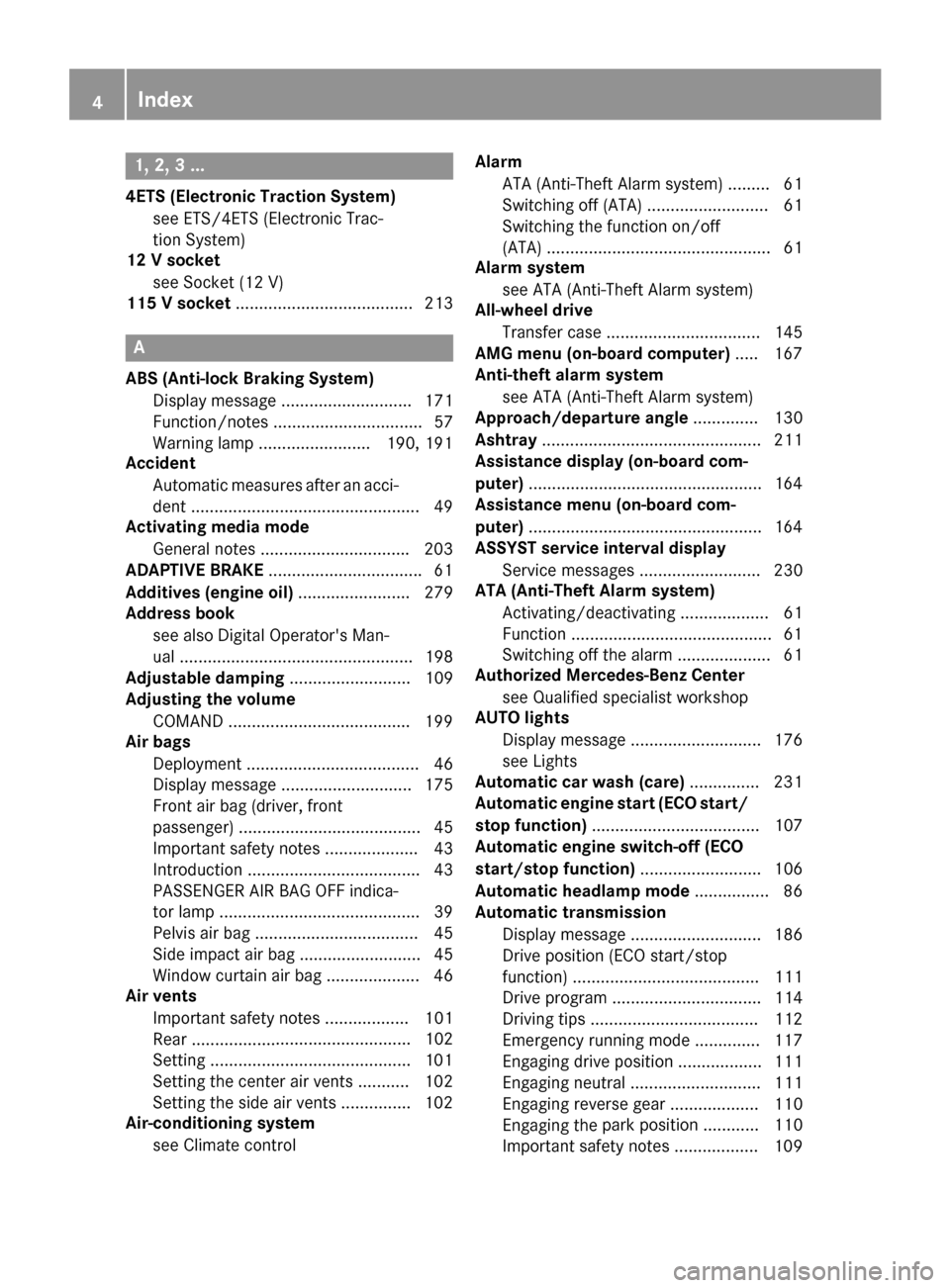
1, 2,3...
4ETS (Electronic Traction System)
see ETS/4ETS (Electronic Trac-
tion System)
12 Vsocket
see Socket (12 V)
115 Vsocket ...................................... 213
A
ABS (Anti-lock Braking System)
Display message ............................ 171
Function/notes ................................ 57
Warnin glamp ........................ 190,1 91
Accident
Automatic measures after an acci-
dent .................................................4 9
Activatin gmedia mode
General note s............................... .203
ADAPTIVE BRAKE ................................ .61
Additives (engineo il)........................ 279
Addres sbook
see also Dig ital Operator's Man-
ual .................................................. 198
Adjustabl edampi ng.......................... 109
Adjusting th evolume
COMAND ...................................... .199
Ai rb ags
Deployment ..................................... 46
Display message ............................ 175
Front ai rbag (driver, front
passenger). ...................................... 45
Important safety notes .................... 43
Introduction ..................................... 43
PASSENGER AIR BAG OFF indica-
tor lamp ...........................................3 9
Pelvis air bag ................................... 45
Side impact air bag .......................... 45
Window curtain air bag .................... 46
Air vents
Important safety notes .................. 101
Rear .................. ............................. 102
Set
ting ...........................................1 01
Setting the center ai rvents ........... 102
Setting the sidea irvents ...............1 02
Air-conditionings ystem
see Climate control Alarm
ATA (Anti-Theft Alarm system) ......... 61
Switching off (ATA) .......................... 61
Switching the function on/off
(ATA) ................................................ 61
Alarm system
see ATA (Anti-Theft Alarm system)
All-whee ldrive
Transfe rcase ................................. 145
AMG menu (on-board computer) ..... 167
Anti-theft alarm system
see ATA (Anti-Theft Alarm system)
Approach/departure angle .............. 130
Ashtray ............................................... 211
Assistanced isplay (on-board com-
puter) ..................................................1 64
Assistancem enu (on-board com-
puter) ..................................................1 64
ASSYST service interval display
Service messages .......................... 230
ATA (Anti-Theft Alarm system)
Activating/deactivating ................... 61
Function ...........................................6 1
Switching off the alarm .................... 61
Authorized Mercedes-Benz Center
see Qualifie dspecialist workshop
AUTO lights
Displa ymessage ............................ 176
see Lights
Automatic car was h(care) ............... 231
Automatic engine start (ECO start/
stopf unction) .................................... 107
Automatic engine switch-of f(EC O
start/stopf unction).......................... 106
Automatic headlamp mode ................ 86
Automatic transmission
Displa ymessage ............................ 186
Drive position (ECOs tart/stop
function) ........................................ 111
Drive program. ............................... 114
Driving tip s.................................... 112
Emergency running mode. ............. 117
Engaging drive position .................. 111
Engaging neutral ............................ 111
Engaging reverse gea r................... 110
Engaging the park p
osition ............ 110
Important safety notes .................. 109
4Index
Page 17 of 286
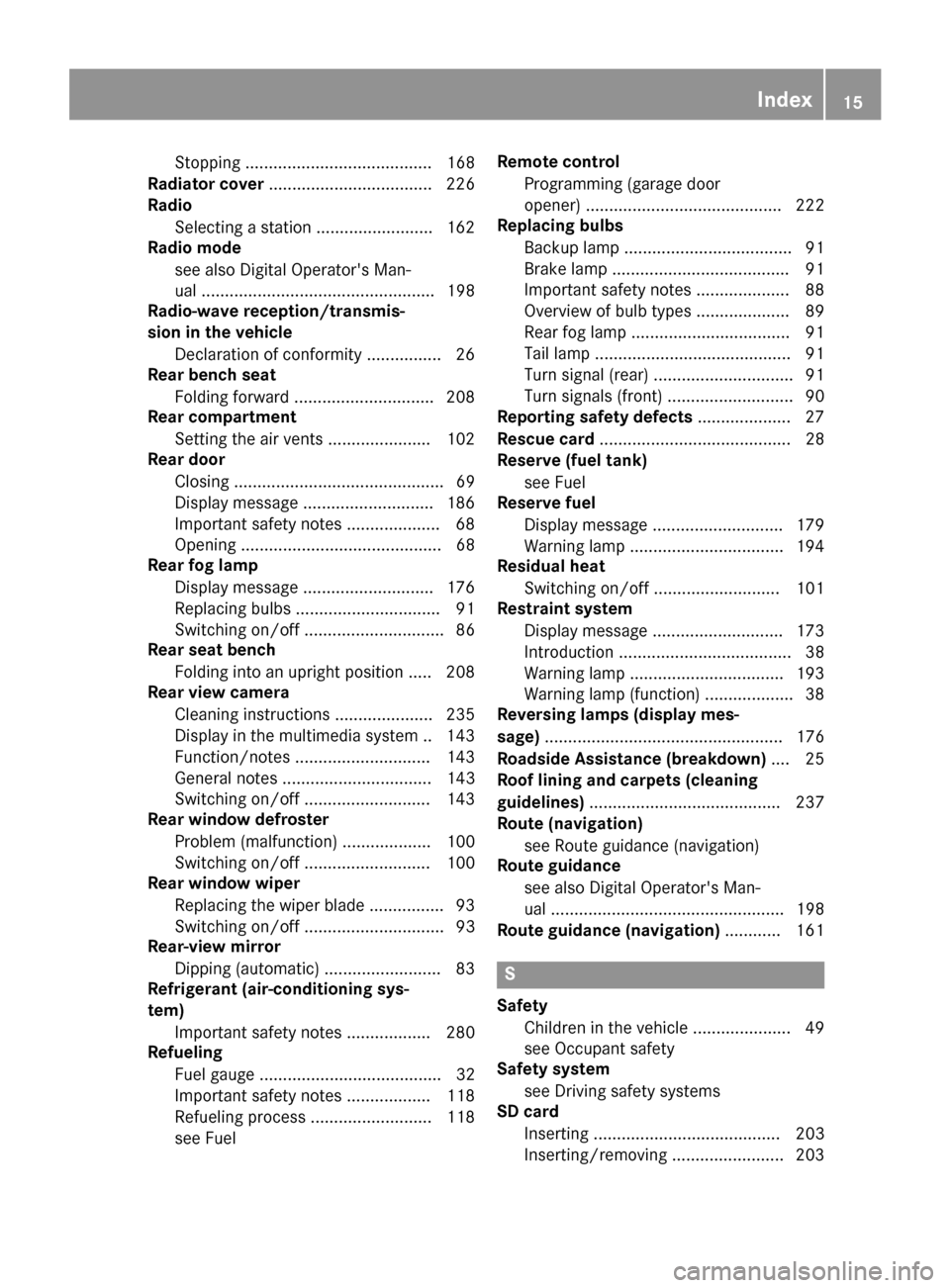
Stopping ........................................ 168
Radiato rcover ................................... 226
Radio
Selecting astation ......................... 162
Radio mode
see also Digital Operator's Man-
ual.................................................. 198
Radio-wave reception/transmis-
sion in the vehicle
Declaration of conformity ................ 26
Rear benchs eat
Folding forward .............................. 208
Rear compartment
Setting the ai rvents ...................... 102
Rear door
Closing ............................................. 69
Displa ymessage ............................ 186
Important safety notes .................... 68
Opening ........................................... 68
Rear fog lamp
Displa ymessage ............................ 176
Replacing bulb s............................... 91
Switching on/off. ............................. 86
Rear seat bench
Folding into an upright position ..... 208
Rear vie wcamera
Cleaning instructions ..................... 235
Displa yinthe multimedi asystem .. 143
Function/note s............................. 143
Generaln otes ................................ 143
Switching on/off. .......................... 143
Rear windowd efroster
Problem (malfunction) ................... 100
Switching on/off. .......................... 100
Rear windoww iper
Replacing the wipe rblade ................ 93
Switching on/off. ............................. 93
Rear-vie wmirror
Dipping (automatic) ......................... 83
Refrigerant (air-conditioning sys-
tem)
Important safety notes .................. 280
Refueling
Fuelgauge ....................................... 32
Important safety notes .................. 118
Refueling process .......................... 118
see Fuel Remote control
Programming (garage door
opener) .......................................... 222
Replacing bulbs
Backu plam p.................................... 91
Brake lamp ...................................... 91
Important safety notes .................... 88
Overview of bulb types .................... 89
Rear fog lamp .................................. 91
Tail lamp .......................................... 91
Turn signal (rear) .............................. 91
Turn signals (front) ........................... 90
Reporting safety defects .................... 27
Rescue card ......................................... 28
Re
serve (fuel tank)
see Fuel
Reserve fuel
Displa ymessage ............................ 179
Warning lamp ................................. 194
Residual heat
Switching on/off. .......................... 101
Restrain tsystem
Displa ymessage ............................ 173
Introduction ..................................... 38
Warning lamp ................................. 193
Warning lamp (function) ................... 38
Reversin glamps (display mes-
sage) ................................................... 176
Roadside Assistance (breakdown) .... 25
Roo flinin gand carpets (cleaning
guidelines) ......................................... 237
Route (navigation)
see Route guidance (navigation)
Route guidance
see also Digital Operator's Man-
ual.................................................. 198
Route guidance( navigation) ............ 161
S
Safety
Childre ninthe vehicl e..................... 49
see Occupant safety
Safety system
see Driving safety systems
SD card
Inserting ........................................ 203
Inserting/removing ........................ 203
Index15
Page 109 of 286
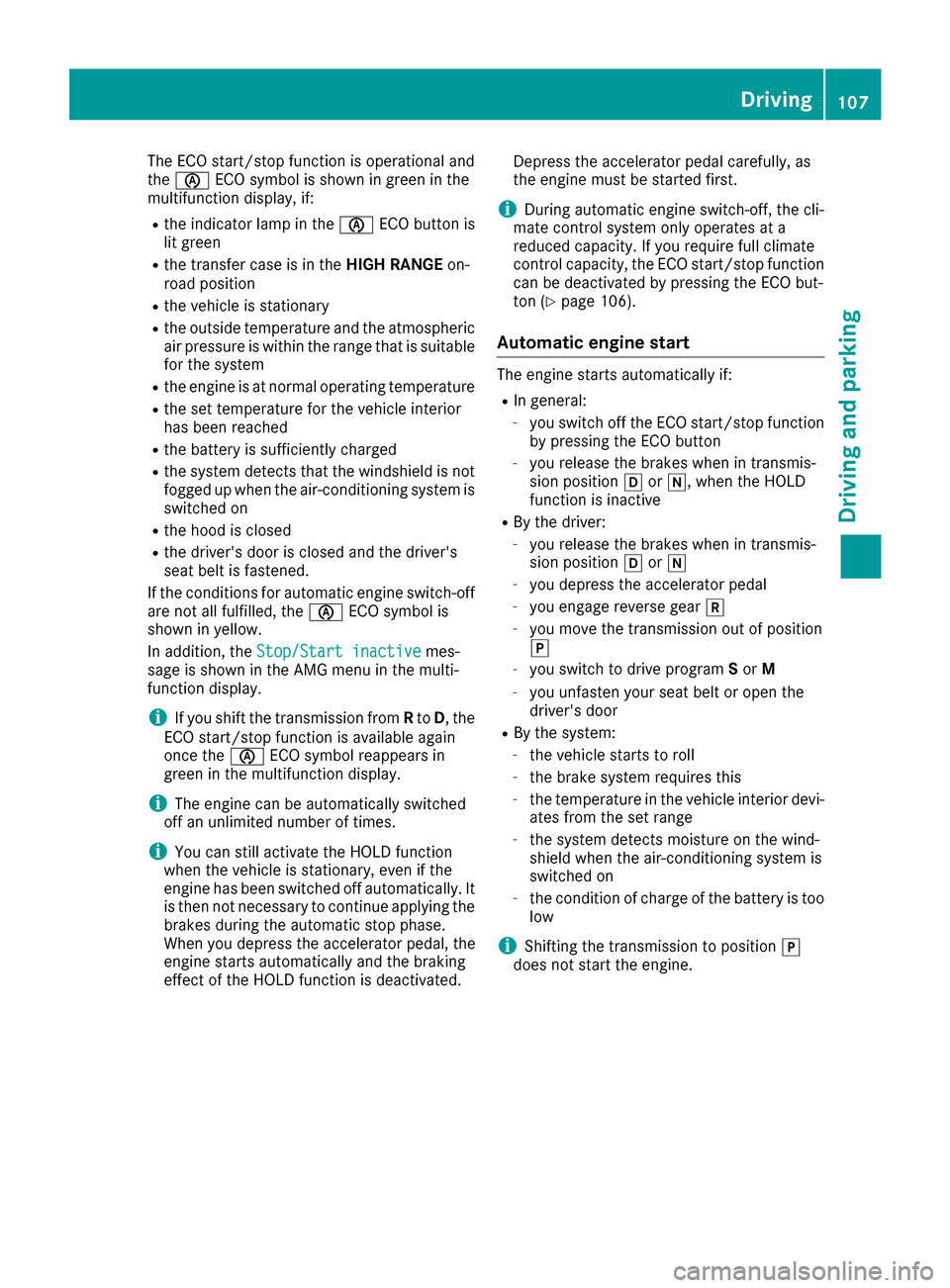
The ECO start/stopfunction is operational and
the è ECO symbol is shown in green in the
multifunction display,i f:
Rthe indicator lamp in the èECO button is
lit green
Rthe transfer case is in the HIGH RANGEon-
road position
Rthe vehicle is stationary
Rthe outside temperature and the atmospheric
air pressure is within the range that is suitable
for the system
Rthe engine is at normal operating temperature
Rthe set temperature for the vehicle interior
has been reached
Rthe battery is sufficiently charged
Rthe system detect sthat the windshield is not
fogged up when the air-conditioning system is switched on
Rthe hood is closed
Rthe driver's door is closed and the driver's
seat belt is fastened.
If the conditions for automatic engine switch-off
are not all fulfilled, the èECO symbol is
shown in yellow.
In addition, the Stop/Start inactive
mes-
sage is shown in the AMG menu in the multi-
function display.
iIf you shift the transmission from Rto D,t he
ECO start/sto pfunction is availablea gain
once the èECO symbol reappears in
green in the multifunction display.
iThe engine can be automatically switched
off an unlimited number of times.
iYou can still activate the HOLD function
when the vehicle is stationary, even if the
engine has been switched off automatically. It
is then not necessary to continue applying the
brakes during the automatic stop phase.
When you depress the accelerator pedal, the
engine start sautomatically and the braking
effect of the HOLD function is deactivated. Depress the accelerator pedal carefully, as
the engine must be started first.
iDuring automatic engine switch-off, the cli-
mate control system only operates at a
reduced capacity. If you require full climate
control capacity, the ECO start/sto pfunction
can be deactivated by pressing the ECO but-
ton (
Ypage 106).
Automatic engine start
The engine start sautomatically if:
RIn general:
-you switch off the ECO start/sto pfunction
by pressing the ECO button
-you release the brakes when in transmis-
sion position hori,w hen the HOLD
function is inactive
RBy the driver:
-you release the brakes when in transmis-
sion position hori
-you depress the accelerator pedal
-you engage reverse gear k
-you move the transmission out of position
j
-you switch to drive program Sor M
-you unfasten your seat belt or open the
driver's door
RBy the system:
-the vehicle start storoll
-the brake system requires this
-the temperature in the vehicle interior devi-
ates from the set range
-the system detect smoisture on the wind-
shield when the air-conditioning system is
switched on
-the condition of charge of the battery is too
low
iShifting the transmission to position j
does not start the engine.
Driving107
Driving and parking
Z
Page 157 of 286
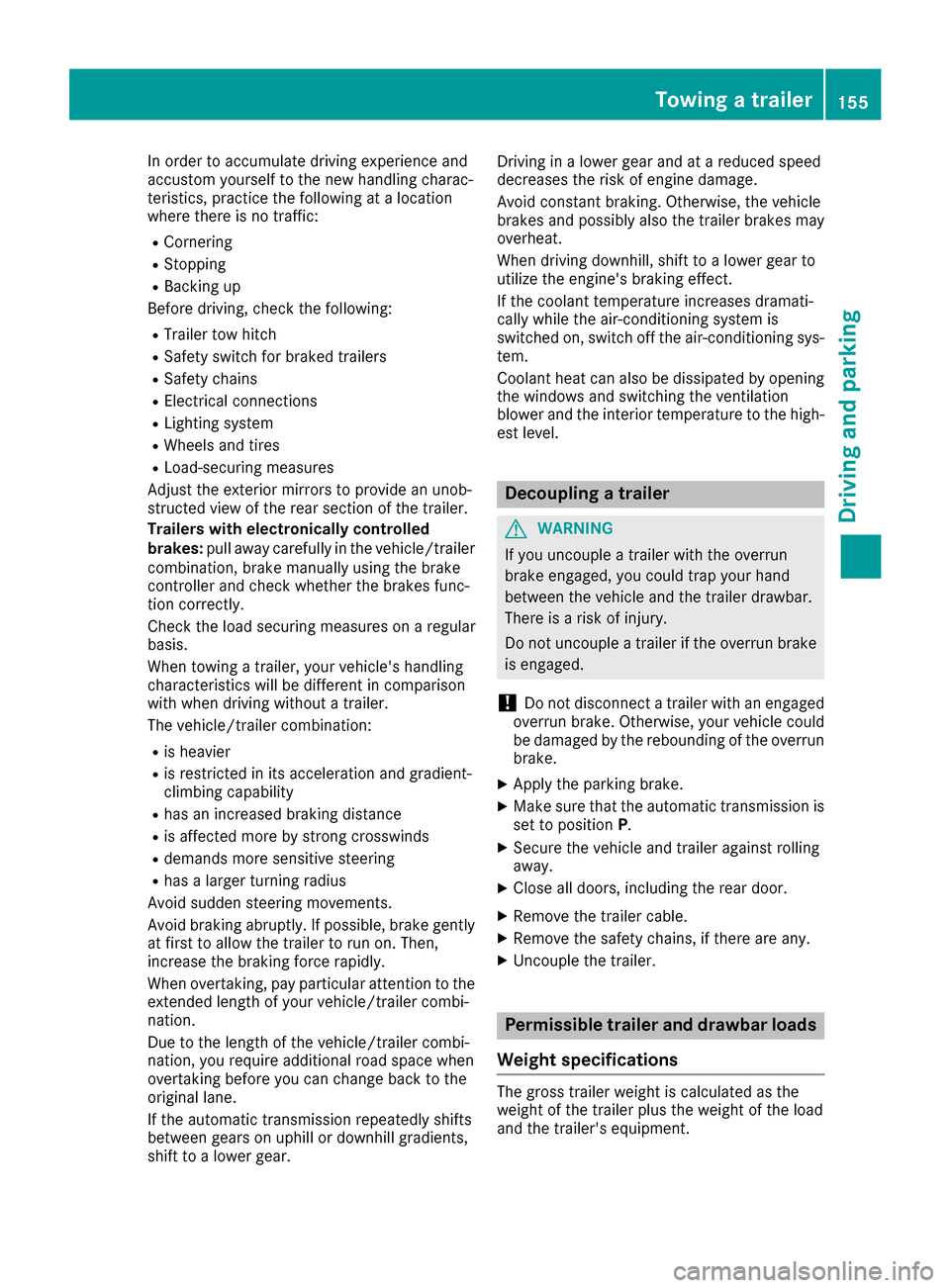
In order to accumulate driving experience and
accustom yourself to the new handling charac-
teristics, practice the following atalocation
where there is no traffic:
RCornering
RStopping
RBacking up
Before driving, check the following:
RTrailer tow hitch
RSafety switch for braked trailers
RSafety chains
RElectrical connections
RLighting system
RWheelsa nd tires
RLoad-securing measures
Adjust the exterior mirrors to provide an unob-
structed view of the rear section of the trailer.
Trailers with electronically controlled
brakes: pullawaycarefully in the vehicle/trailer
combination, brake manually using the brake
controller and check whether the brakes func-
tion correctly.
Check the load securing measures on aregular
basis.
When towing atrailer, you rvehicle's handling
characteristics willbed ifferent in comparison
with when driving withoutat railer.
The vehicle/trailer combination:
Ris heavier
Ris restricted in its acceleration and gradient-
climbing capability
Rhas an increased braking distance
Ris affected more by strong crosswinds
Rdemands more sensitive steering
Rhas alargert urning radius
Avoid sudden steering movements.
Avoid braking abruptly. If possible, brake gently
at first to allow the trailer to run on. Then,
increase the braking force rapidly.
When overtaking, pay particular attention to the
extended length of you rvehicle/trailer combi-
nation.
Due to the length of the vehicle/trailer combi-
nation, you require additional road space when
overtaking before you can change back to the
originall ane.
If the automatic transmission repeatedly shifts
betweeng ears on uphill or downhill gradients,
shift to alowerg ear. Driving in
alowerg ear and at areduced speed
decreases the risk of engine damage.
Avoid constant braking. Otherwise,t he vehicle
brakes and possibly also the trailerb rakes may
overheat.
When driving downhill, shift to alowerg ear to
utilize the engine's braking effect.
If the coolant temperature increases dramati-
cally whilet he air-conditioning system is
switched on, switch off the air-conditioning sys- tem.
Coolant heat can also be dissipated by opening
the windowsa
nd sw
itching the ventilation
blower and the interior temperature to the high-
est level.
Decoupling atrailer
GWARNING
If you uncoupl eatrailerwith the overrun
brake engaged,y ou could trap you rhand
betweent he vehicle and the trailerd rawbar.
There is arisk of injury.
Do not uncoupl eatrailerift he overrun brake
is engaged.
!Do not disconnect atraile rwith an engaged
overrun brake. Otherwise,y ourv ehicle could
be damaged by the rebounding of the overrun
brake.
XApply the parking brake.
XMake sure that the automatic transmission is
set to position P.
XSecure the vehicle and trailera gainst rolling
away.
XClose all doors, including the rear door.
XRemove the trailerc able.
XRemove the safety chains, if there are any.
XUncouple the trailer.
Permissible trailer and drawbar loads
Weight specifications
The gross trailerw eight is calculated as the
weight of the trailerp lusthe weight of the load
and the trailer'se quipment.
Towingatrailer155
Driving and parking
Z
Page 270 of 286
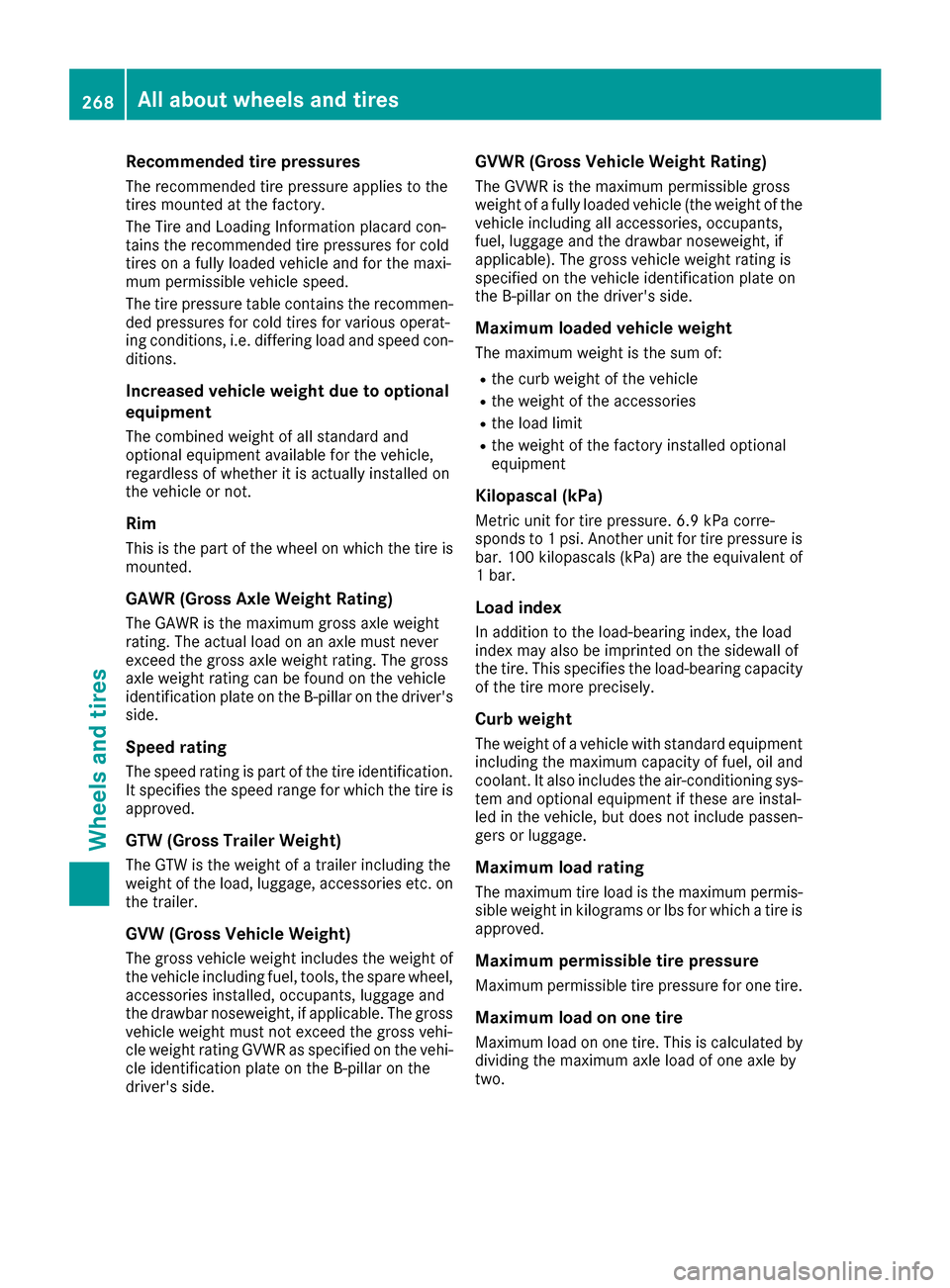
Recommendedtire pressures
The recommended tire pressure applie stothe
tire sm ounted at the factory.
The Tir eand Loading Information placard con-
tains the recommended tire pressures for cold
tire sonaf ully loaded vehicle and for the maxi-
mum permissible vehicle speed.
The tire pressure table contains the recommen- ded pressures for coldt iresfor variou soperat-
ing conditions ,i.e .d iffering loa dand speed con-
ditions.
Increasedv ehicle weight due to optional
equipment
The combined weigh tofallstandard and
optionale quipment available for the vehicle,
regardless of whether it is actually installed on
the vehicle or not.
Rim
Thisist he part of the wheel on which the tire is
mounted.
GAW R(Gross Axle Weight Rating)
The GAW Risthe maximum grossa xlew eight
rating. The actual loa donanaxlem ustn ever
excee dthe grossa xlew eigh trating. The gross
axl ew eigh trating can be found on the vehicle
identification plate on the B-pillar on the driver's
side.
Speed rating
The speed rating is part of the tire identification. It specifies the speed rang efor which the tire is
approved.
GTW (Gross Trailer Weight)
The GT Wisthe weigh tofatraile rincluding the
weigh tofthe load, luggage, accessorie setc. on
the trailer.
GVW (Gross Vehicl eWeight)
The grossv ehicle weigh tincludes the weigh tof
the vehicle including fuel, tools, the spare wheel,
accessorie sinstalled, occupants, luggage and
the drawbar noseweight, if applicable. The gross
vehicle weigh tmustn ot excee dthe grossv ehi-
cle weigh trating GVW Rasspecified on the vehi-
cle identification plate on the B-pillar on the
driver'ss ide.
GVWR (Gross Vehicl eWeight Rating)
The GVW Risthe maximum permissible gross
weigh tofafully loaded vehicle (the weigh tofthe
vehicle including al laccessories, occupants,
fuel, luggage and the drawbar noseweight, if
applicable). The grossv ehicle weightrating is
specified on the vehicle identification plate on
the B-pillar on the driver'ss ide.
Maximum loaded vehicle weight
The maximum weightist he sumo f:
Rthe curb weigh tofthe vehicle
Rthe weigh tofthe accessories
Rthe loa dlim it
Rthe weigh tofthe factory installed optional
equipment
Kilopascal (kPa)
Metricu nitf or tire pressure. 6.9 kPa corre-
sponds to 1psi.A nother uni tfor tire pressure is
bar. 100 kilopascals (kPa )are the equivalent of
1b ar.
Load index
In addition to the load-bearing index, the load
index may also be imprinte donthe sidewal lof
the tire .Thiss pecifies the load-bearing capacity
of the tire more precisely.
Curb weight
The weigh tofavehicle with standard equipment
incl uding the maximum capacity of fuel, oil and
coolant. It also includes the air-conditioning sys-
tem and optionale quipment if thesea re instal-
le dint he vehicle ,but doe snot includ epassen-
ger sorl uggage.
Maximum load rating
The maximum tire loa disthe maximum permis-
sible weigh tinkilograms or lb sfor which atire is
approved.
Maximum permissiblet ire pressure
Maximumpermissible tire pressure for one tire.
Maximum load on on etire
Maximu mloadono ne tire .Thisisc alculate dby
dividing the maximum axl eloa dofo ne axl eby
two.
268Al la bout wheels and tires
Wheels and tires